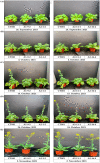CRISPR/Cas9-Mediated Editing of AGAMOUS-like Genes Results in a Late-Bolting Phenotype in Chinese Cabbage (Brassica rapa ssp. pekinensis)
- PMID: 36499334
- PMCID: PMC9735848
- DOI: 10.3390/ijms232315009
CRISPR/Cas9-Mediated Editing of AGAMOUS-like Genes Results in a Late-Bolting Phenotype in Chinese Cabbage (Brassica rapa ssp. pekinensis)
Abstract
Due to the sudden change in temperature in spring, Chinese cabbage, a leafy vegetable cultivated for consumption, loses its commercial value due to the onset of bolting—the phenomenon of switching from vegetative to reproductive growth. In this study, we applied clustered regularly interspaced short palindromic repeats/(CRISPR)-associated system 9 (CRISPR/Cas9) technology to analyze AGAMOUS-like genes. We performed functional analysis of AGL19 and AGL24 genes related to bolting and flowering using CRISPR/Cas9-mediated Chinese cabbage transformation. Single-guide RNA (sgRNA) sequences were created with a low off-targeting probability to construct gene-editing vectors. Agrobacterium-mediated transformation was conducted, and tentative E0 AGL-edited lines were analyzed using molecular biotechnological methods. Two AGL19-edited lines with nucleotide sequence mutations in the target sequence of the AGL19 genes and four AGL24-edited lines with nucleotide sequence mutations in the target sequence of the AGL24 genes showed particularly late bolting compared to the inbred line ‘CT001.’ Generational progression using bud pollination obtained T-DNA-free E1 AGL-edited lines, which also showed late bolting. The loss of function of the AGL protein was caused by the occurrence of an indel mutation in the AGL19 and AGL24 genes, which results in an early stop codon. Furthermore, frameshift mutations led to structural changes and the introduction of an early stop codon in the AGL19 and AGL24 proteins. Our results indicate that CRISPR/Cas9-mediated editing of AGAMOUS-like genes results in a late-bolting phenotype and that CRISPR/Cas9 is a useful technology for analyzing gene function in Chinese cabbage (Brassica rapa ssp. pekinensis).
Keywords: AGL19 gene; AGL24 gene; Brassica rapa; CRISPR/Cas9; late bolting.
Conflict of interest statement
The authors declare no conflict of interest.
Figures







Similar articles
-
CRISPR/Cas9-Mediated Mutagenesis of BrLEAFY Delays the Bolting Time in Chinese Cabbage (Brassica rapa L. ssp. pekinensis).Int J Mol Sci. 2022 Dec 29;24(1):541. doi: 10.3390/ijms24010541. Int J Mol Sci. 2022. PMID: 36613993 Free PMC article.
-
A single amino acid residue substitution in BraA04g017190.3C, a histone methyltransferase, results in premature bolting in Chinese cabbage (Brassica rapa L. ssp. Pekinensis).BMC Plant Biol. 2021 Aug 13;21(1):373. doi: 10.1186/s12870-021-03153-9. BMC Plant Biol. 2021. PMID: 34388969 Free PMC article.
-
Function Analysis of the PR55/B Gene Related to Self-Incompatibility in Chinese Cabbage Using CRISPR/Cas9.Int J Mol Sci. 2022 May 3;23(9):5062. doi: 10.3390/ijms23095062. Int J Mol Sci. 2022. PMID: 35563453 Free PMC article.
-
Gene co-expression network analysis reveals key pathways and hub genes in Chinese cabbage (Brassica rapa L.) during vernalization.BMC Genomics. 2021 Apr 6;22(1):236. doi: 10.1186/s12864-021-07510-8. BMC Genomics. 2021. PMID: 33823810 Free PMC article. Review.
-
The CRISPR/Cas9 system and its applications in crop genome editing.Crit Rev Biotechnol. 2019 May;39(3):321-336. doi: 10.1080/07388551.2018.1554621. Epub 2019 Jan 15. Crit Rev Biotechnol. 2019. PMID: 30646772 Review.
Cited by
-
Efficient double-flowered gentian plant production using the CRISPR/Cas9 system.Plant Biotechnol (Tokyo). 2023 Sep 25;40(3):229-236. doi: 10.5511/plantbiotechnology.23.0424a. Plant Biotechnol (Tokyo). 2023. PMID: 38420567 Free PMC article.
-
CRISPR-Cas technology secures sustainability through its applications: a review in green biotechnology.3 Biotech. 2023 Nov;13(11):383. doi: 10.1007/s13205-023-03786-7. Epub 2023 Oct 31. 3 Biotech. 2023. PMID: 37920190 Free PMC article. Review.
-
CRISPR/Cas9-Mediated Mutagenesis of BrLEAFY Delays the Bolting Time in Chinese Cabbage (Brassica rapa L. ssp. pekinensis).Int J Mol Sci. 2022 Dec 29;24(1):541. doi: 10.3390/ijms24010541. Int J Mol Sci. 2022. PMID: 36613993 Free PMC article.
-
Genetic Analysis Based on CRISPR/Cas9 Technology in Plants.Int J Mol Sci. 2023 Nov 16;24(22):16398. doi: 10.3390/ijms242216398. Int J Mol Sci. 2023. PMID: 38003586 Free PMC article.
-
CRISPR/Cas9: efficient and emerging scope for Brassica crop improvement.Planta. 2025 Jun 4;262(1):14. doi: 10.1007/s00425-025-04727-9. Planta. 2025. PMID: 40464976 Review.
References
-
- Xie F., Zha J., Tang H., Xu Y., Liu X., Wan Z. Combining ability and heterosis analysis for mineral elements by using cytoplasmic male-sterile systems in non-heading Chinese cabbage (Brassica rapa) Crop Pasture Sci. 2018;69:296–302. doi: 10.1071/CP17357. - DOI
-
- Kim C.G. The Impact of Climate Change on the Agricultural Sector: Implications of the Agro-Industry For low Carbon, Green Growth Strategy and Roadmap for the East Asian Region. Korea Rural Economic Institute; Naju, Republic of Korea: 2008.
-
- Wang Y., Chen L., Su W., Hao Y., Liu H., Sun G., Chen R., Song S. Effect of Nitrate Concentration on the Growth, Bolting and Related Gene Expression in Flowering Chinese Cabbage. Agron. J. 2021;11:936. doi: 10.3390/agronomy11050936. - DOI
MeSH terms
Grants and funding
LinkOut - more resources
Full Text Sources

